Low Country
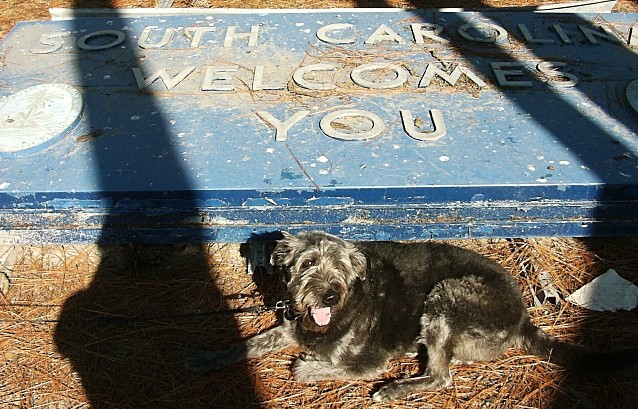
In late 1999, Trout had his picture taken (poorly in most cases) at the Alabama, Florida and Georgia state lines.
Now the 'Trout Across America' series continues with this much anticipated fourth installment. Unfortunately in
his zeal, Trout knocked over the sign. Undaunted we present the horizontal version instead. Enjoy.
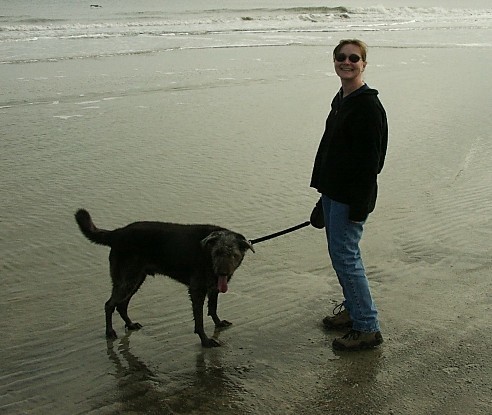
Later that day we arrived on Hunting Island, South Carolina which is about 20 miles (32 km) southeast of Beaufort.
There is a lovely campground at the state park there which was relatively uncrowded in mid-January. The tides are
substantial on Hunting Island but at low tide there is quite a lot of beach to romp on. Here is Melanie, Trout, and
nearly all of Trout's tongue on that beach.
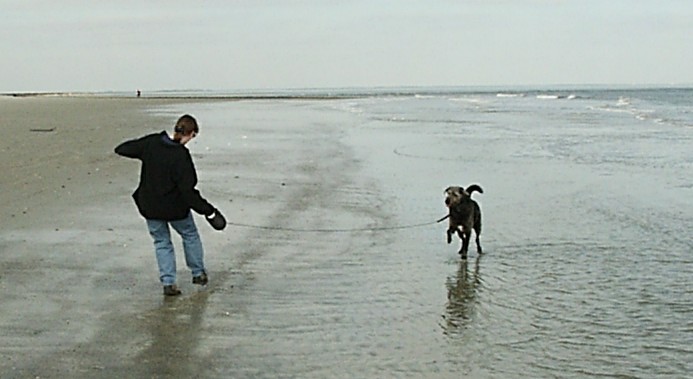
Trout is relatively impartial to which beach we may be on as long as there are things to chase. Of course, things to
chase really means sand and water so he's likely to be happy anywhere. Here is an exciting action shot of Melanie
kicking sand at the dog. Trout is in three-legged prepare-to-pounce stance. Trout has never figured out that the
entire beach is sand, not just the kicked part, but perhaps that is for the best. Later we took Trout on a couple miles
of hiking trails which criss-cross the island.

That along with the night-time beach walk left Trout pretty tired. In fact, he never even woke up when a porcupine wandered
past the tent making loud ruffling porcupine noises. The coastal area of South Carolina is the world center of an odd sub-culture.
The Gullah language and culture originated with slaves brought to the United States to farm rice from Angola and Liberia. For
some reason the Gullah language which developed has survived in small pockets amongst the islands and there is even a
Gullah cultural center near Beaufort.
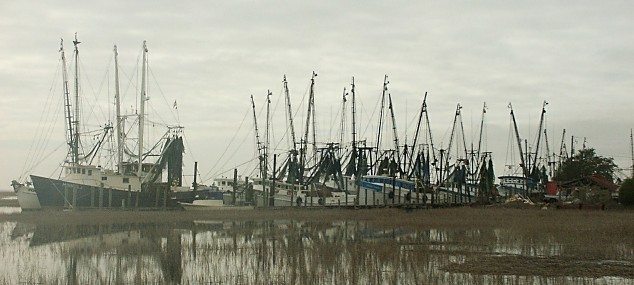
The biggest industry in the low country area of South Carolina is shrimping. Nearby Hilton Head claims to be the birthplace
of the modern shrimping industry. If this looks like a scene from the movie 'Forrest Gump', it isn't too surprising. It was filmed
at several locations nearby.
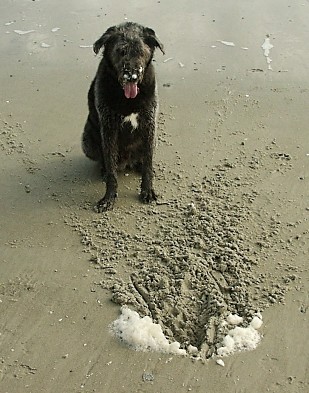
The next morning we went to Hilton Head to see what it was. We mostly expected an overdeveloped resort island
and a beach lined with high-rise condos and hotels. Actually it turned out to be an overdeveloped resort island and
beach with secluded resorts and an infinite number of gated subdivisions with golf courses designed by the PGA celebrity
of your choice. Either way, the beaches are leash-free for dogs under voice control between October and March so Trout
enjoyed it. Here is Trout with salt foam on his nose. There's really nothing else to say about that.

Here is a crab that Trout met. Both Trout and the crab have short attention spans so the meeting was brief and
uneventful. There seems to be pretty good shelling along Hilton Head Island but the vast majority of shells are
quite small. The island has two public beaches and we visited them both. They really aren't much different but we'd
recommend the one at the north end of the island because the parking area is nicer and there is more parking
available. Plus you're less likely to be killed in traffic returning to your car from the beach.

Not far south of Hilton Head is the city of Savannah, Georgia. Savannah is one of the oddest towns you can
expect to find yourself in, though it is very picturesque. The city was thoughtfully laid out with 25 grassy squares
left as parks. Over the years since its founding, three of the parks have been lost but the rest remain. Here is Trout
in the Garden of Good and Evil. Or if you prefer, 5 of Savannah's parks. This first is Reynolds Square. The statue
in the center is of John Wesley (founder of Methodism).
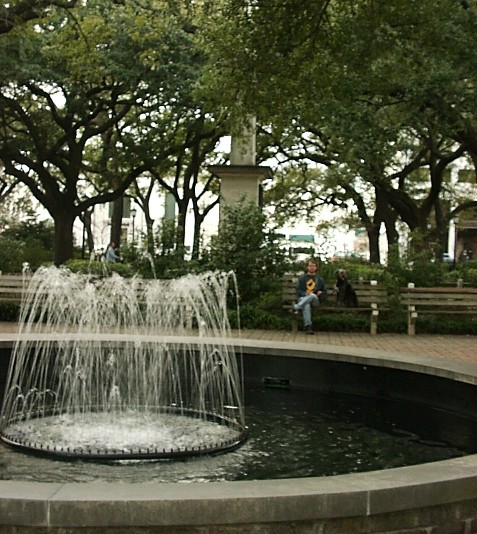
This is Johnson Square, the first square of the Savannah plan. Robert Johnson was a governor of South
Carolina which is actually across the river but he gets a square in Savannah anyway. The statue you can't
see on top of the column is of Nathaniel Greene.

Wright Square features more squirrels per capita than any other Savannah square according to Trout. According to
local history, it was named for Sir James Wright, a colonial General and the monument honors William Washington
Gordon. If you're starting to suspect Savannah has monuments to a lot of people you're on the right track but you're
probably an order of magnitude off still.

This is Chippewa square, named after the Battle of Chippewa which happened in not-very-nearby Canada. Go figure.
This monument is William Oglethorpe the founder of the Georgia colony who was important enough to be sculpted
by Daniel Chester French. Trout is suitably impressed

Sociologists have determined that more than five of these pictures would likely cause you, the reader, to glaze over
and pass out on your keyboard. So this is the last one for now. This is called Oglethorpe Square even though the
statue of Oglethorpe was in Chippewa Square. So what, there is also a Greene square which doesn't feature the
statue of Nathaniel Greene. This square features the house in the background which is historic because maybe, just
maybe the Marquis de Lafayette stayed there once as a guest. Maybe. The supporting evidence for such a visit is
described as 'Savannah oral tradition'. The Savannah mentality about this is basically that if you don't accept it, you
shouldn't really be living in Savannah. We were just passing through so we leave the veracity of such things as an
exercise to the industrious reader.
 In late 1999, Trout had his picture taken (poorly in most cases) at the Alabama, Florida and Georgia state lines.
Now the 'Trout Across America' series continues with this much anticipated fourth installment. Unfortunately in
his zeal, Trout knocked over the sign. Undaunted we present the horizontal version instead. Enjoy.
In late 1999, Trout had his picture taken (poorly in most cases) at the Alabama, Florida and Georgia state lines.
Now the 'Trout Across America' series continues with this much anticipated fourth installment. Unfortunately in
his zeal, Trout knocked over the sign. Undaunted we present the horizontal version instead. Enjoy.
 In late 1999, Trout had his picture taken (poorly in most cases) at the Alabama, Florida and Georgia state lines.
Now the 'Trout Across America' series continues with this much anticipated fourth installment. Unfortunately in
his zeal, Trout knocked over the sign. Undaunted we present the horizontal version instead. Enjoy.
In late 1999, Trout had his picture taken (poorly in most cases) at the Alabama, Florida and Georgia state lines.
Now the 'Trout Across America' series continues with this much anticipated fourth installment. Unfortunately in
his zeal, Trout knocked over the sign. Undaunted we present the horizontal version instead. Enjoy.
 Later that day we arrived on Hunting Island, South Carolina which is about 20 miles (32 km) southeast of Beaufort.
There is a lovely campground at the state park there which was relatively uncrowded in mid-January. The tides are
substantial on Hunting Island but at low tide there is quite a lot of beach to romp on. Here is Melanie, Trout, and
nearly all of Trout's tongue on that beach.
Later that day we arrived on Hunting Island, South Carolina which is about 20 miles (32 km) southeast of Beaufort.
There is a lovely campground at the state park there which was relatively uncrowded in mid-January. The tides are
substantial on Hunting Island but at low tide there is quite a lot of beach to romp on. Here is Melanie, Trout, and
nearly all of Trout's tongue on that beach.
 Trout is relatively impartial to which beach we may be on as long as there are things to chase. Of course, things to
chase really means sand and water so he's likely to be happy anywhere. Here is an exciting action shot of Melanie
kicking sand at the dog. Trout is in three-legged prepare-to-pounce stance. Trout has never figured out that the
entire beach is sand, not just the kicked part, but perhaps that is for the best. Later we took Trout on a couple miles
of hiking trails which criss-cross the island.
Trout is relatively impartial to which beach we may be on as long as there are things to chase. Of course, things to
chase really means sand and water so he's likely to be happy anywhere. Here is an exciting action shot of Melanie
kicking sand at the dog. Trout is in three-legged prepare-to-pounce stance. Trout has never figured out that the
entire beach is sand, not just the kicked part, but perhaps that is for the best. Later we took Trout on a couple miles
of hiking trails which criss-cross the island.  That along with the night-time beach walk left Trout pretty tired. In fact, he never even woke up when a porcupine wandered
past the tent making loud ruffling porcupine noises. The coastal area of South Carolina is the world center of an odd sub-culture.
The Gullah language and culture originated with slaves brought to the United States to farm rice from Angola and Liberia. For
some reason the Gullah language which developed has survived in small pockets amongst the islands and there is even a
Gullah cultural center near Beaufort.
That along with the night-time beach walk left Trout pretty tired. In fact, he never even woke up when a porcupine wandered
past the tent making loud ruffling porcupine noises. The coastal area of South Carolina is the world center of an odd sub-culture.
The Gullah language and culture originated with slaves brought to the United States to farm rice from Angola and Liberia. For
some reason the Gullah language which developed has survived in small pockets amongst the islands and there is even a
Gullah cultural center near Beaufort.  The biggest industry in the low country area of South Carolina is shrimping. Nearby Hilton Head claims to be the birthplace
of the modern shrimping industry. If this looks like a scene from the movie 'Forrest Gump', it isn't too surprising. It was filmed
at several locations nearby.
The biggest industry in the low country area of South Carolina is shrimping. Nearby Hilton Head claims to be the birthplace
of the modern shrimping industry. If this looks like a scene from the movie 'Forrest Gump', it isn't too surprising. It was filmed
at several locations nearby.  The next morning we went to Hilton Head to see what it was. We mostly expected an overdeveloped resort island
and a beach lined with high-rise condos and hotels. Actually it turned out to be an overdeveloped resort island and
beach with secluded resorts and an infinite number of gated subdivisions with golf courses designed by the PGA celebrity
of your choice. Either way, the beaches are leash-free for dogs under voice control between October and March so Trout
enjoyed it. Here is Trout with salt foam on his nose. There's really nothing else to say about that.
The next morning we went to Hilton Head to see what it was. We mostly expected an overdeveloped resort island
and a beach lined with high-rise condos and hotels. Actually it turned out to be an overdeveloped resort island and
beach with secluded resorts and an infinite number of gated subdivisions with golf courses designed by the PGA celebrity
of your choice. Either way, the beaches are leash-free for dogs under voice control between October and March so Trout
enjoyed it. Here is Trout with salt foam on his nose. There's really nothing else to say about that.  Here is a crab that Trout met. Both Trout and the crab have short attention spans so the meeting was brief and
uneventful. There seems to be pretty good shelling along Hilton Head Island but the vast majority of shells are
quite small. The island has two public beaches and we visited them both. They really aren't much different but we'd
recommend the one at the north end of the island because the parking area is nicer and there is more parking
available. Plus you're less likely to be killed in traffic returning to your car from the beach.
Here is a crab that Trout met. Both Trout and the crab have short attention spans so the meeting was brief and
uneventful. There seems to be pretty good shelling along Hilton Head Island but the vast majority of shells are
quite small. The island has two public beaches and we visited them both. They really aren't much different but we'd
recommend the one at the north end of the island because the parking area is nicer and there is more parking
available. Plus you're less likely to be killed in traffic returning to your car from the beach.
 Not far south of Hilton Head is the city of Savannah, Georgia. Savannah is one of the oddest towns you can
expect to find yourself in, though it is very picturesque. The city was thoughtfully laid out with 25 grassy squares
left as parks. Over the years since its founding, three of the parks have been lost but the rest remain. Here is Trout
in the Garden of Good and Evil. Or if you prefer, 5 of Savannah's parks. This first is Reynolds Square. The statue
in the center is of John Wesley (founder of Methodism).
Not far south of Hilton Head is the city of Savannah, Georgia. Savannah is one of the oddest towns you can
expect to find yourself in, though it is very picturesque. The city was thoughtfully laid out with 25 grassy squares
left as parks. Over the years since its founding, three of the parks have been lost but the rest remain. Here is Trout
in the Garden of Good and Evil. Or if you prefer, 5 of Savannah's parks. This first is Reynolds Square. The statue
in the center is of John Wesley (founder of Methodism).  This is Johnson Square, the first square of the Savannah plan. Robert Johnson was a governor of South
Carolina which is actually across the river but he gets a square in Savannah anyway. The statue you can't
see on top of the column is of Nathaniel Greene.
This is Johnson Square, the first square of the Savannah plan. Robert Johnson was a governor of South
Carolina which is actually across the river but he gets a square in Savannah anyway. The statue you can't
see on top of the column is of Nathaniel Greene.  Wright Square features more squirrels per capita than any other Savannah square according to Trout. According to
local history, it was named for Sir James Wright, a colonial General and the monument honors William Washington
Gordon. If you're starting to suspect Savannah has monuments to a lot of people you're on the right track but you're
probably an order of magnitude off still.
Wright Square features more squirrels per capita than any other Savannah square according to Trout. According to
local history, it was named for Sir James Wright, a colonial General and the monument honors William Washington
Gordon. If you're starting to suspect Savannah has monuments to a lot of people you're on the right track but you're
probably an order of magnitude off still.  This is Chippewa square, named after the Battle of Chippewa which happened in not-very-nearby Canada. Go figure.
This monument is William Oglethorpe the founder of the Georgia colony who was important enough to be sculpted
by Daniel Chester French. Trout is suitably impressed
This is Chippewa square, named after the Battle of Chippewa which happened in not-very-nearby Canada. Go figure.
This monument is William Oglethorpe the founder of the Georgia colony who was important enough to be sculpted
by Daniel Chester French. Trout is suitably impressed  Sociologists have determined that more than five of these pictures would likely cause you, the reader, to glaze over
and pass out on your keyboard. So this is the last one for now. This is called Oglethorpe Square even though the
statue of Oglethorpe was in Chippewa Square. So what, there is also a Greene square which doesn't feature the
statue of Nathaniel Greene. This square features the house in the background which is historic because maybe, just
maybe the Marquis de Lafayette stayed there once as a guest. Maybe. The supporting evidence for such a visit is
described as 'Savannah oral tradition'. The Savannah mentality about this is basically that if you don't accept it, you
shouldn't really be living in Savannah. We were just passing through so we leave the veracity of such things as an
exercise to the industrious reader.
Sociologists have determined that more than five of these pictures would likely cause you, the reader, to glaze over
and pass out on your keyboard. So this is the last one for now. This is called Oglethorpe Square even though the
statue of Oglethorpe was in Chippewa Square. So what, there is also a Greene square which doesn't feature the
statue of Nathaniel Greene. This square features the house in the background which is historic because maybe, just
maybe the Marquis de Lafayette stayed there once as a guest. Maybe. The supporting evidence for such a visit is
described as 'Savannah oral tradition'. The Savannah mentality about this is basically that if you don't accept it, you
shouldn't really be living in Savannah. We were just passing through so we leave the veracity of such things as an
exercise to the industrious reader.